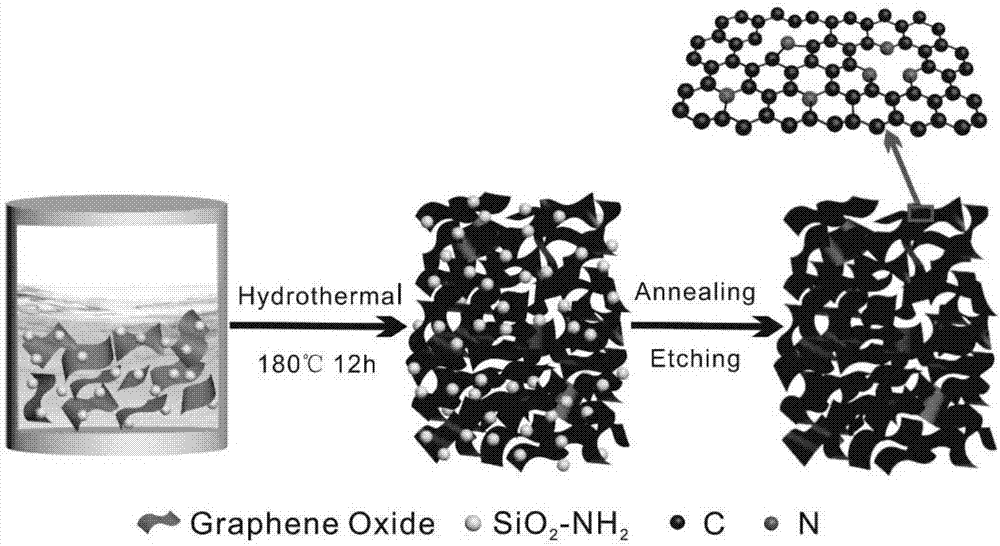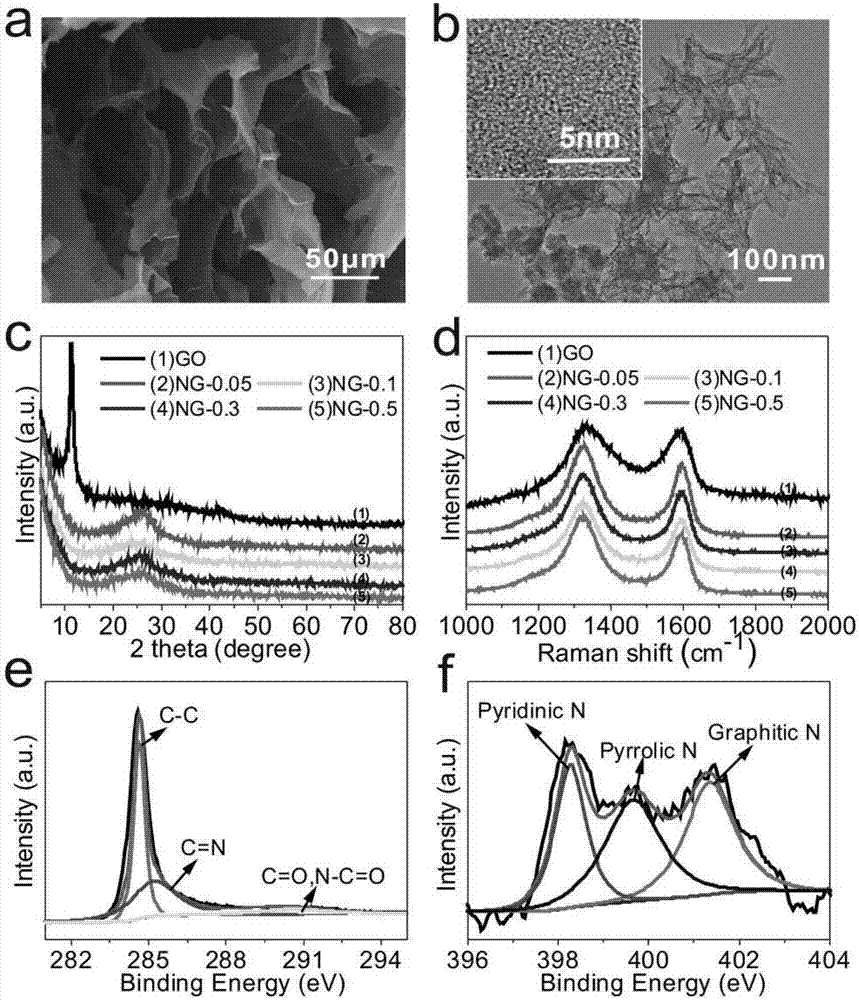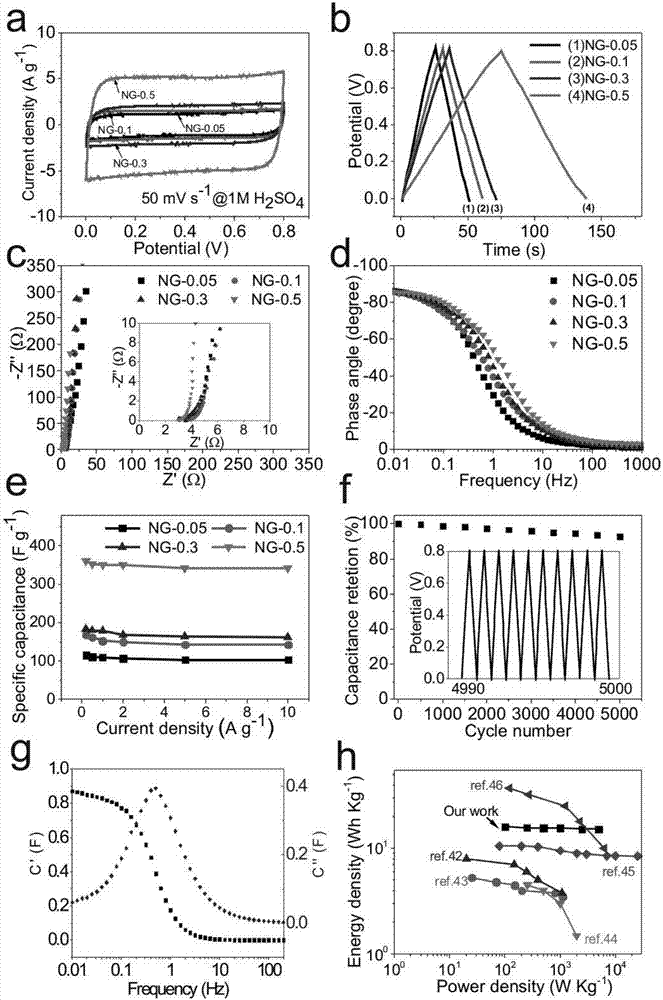Method for preparing nitrogen-doped graphene aerogel by simultaneously using SiO2-NH2 as template and nitrogen doping agent
A graphene airgel and graphene technology, applied in the direction of graphene, nano-carbon, hybrid capacitor electrodes, etc., can solve the problems of limiting the performance of graphene, and achieve the effects of easy promotion, strong practicability, and high adsorption efficiency
- Summary
- Abstract
- Description
- Claims
- Application Information
AI Technical Summary
Problems solved by technology
Method used
Image
Examples
Embodiment 1
[0043] 1 Experimental part
[0044] 1.1 Materials
[0045] Natural graphite flakes (8000 mesh, 99.95% purity), tetraethylsilicate (TEOS) and (3-aminopropyl)triethoxysilane (APTES) were purchased from Aladdin. Concentrated sulfuric acid (95-98%), concentrated hydrochloric acid (36-38%), hydrofluoric acid (40%) and potassium permanganate of analytical grade were purchased from Beijing Chemical Plant (China). Hydrogen peroxide (H 2 o 2 ) and sodium nitrate were provided by Laiyang Shikang Chemical Company. The above-mentioned concentrations are all mass concentrations.
[0046] 1.2 Amino-functionalized silica particles
[0047] Silica was prepared by a modified Stober method. 1 g of silica particles was dispersed in ethanol (100 mL) and sonicated for 15 minutes to ensure uniform dispersion of the dispersion. Then 0.1430 g of APTES was dispersed in ethanol, and then slowly added into the silica suspension, and then stirred at 50° C. for about 24 hours under a nitrogen atmos...
Embodiment 2
[0087] SiO 2 -NH 2 The preparation method is with embodiment 1. Graphene oxide (GO) was prepared from natural graphite using a modified Hummers method. In the synthesis of N-doped airgel, 1 mL of SiO 2 -NH 2 The ethanol dispersions were respectively dispersed in 3 mg / mL GO aqueous solution. The suspension was then sealed in a Teflon-lined stainless steel autoclave for hydrothermal reaction at 160 °C for 14 h. The product was repeatedly washed with distilled water three times, and then freeze-dried to prepare an airgel. The prepared airgel was placed in a tube furnace with two temperature zones, and argon gas was passed through for 15 minutes to exhaust the air. and at 5°C min under argon -1 at a rate of 800 °C, followed by calcination at 800 °C for 1.5 h, and then cooled to room temperature. The resulting N-doped graphene gel was etched with hydrofluoric acid (3-5% molar concentration) and washed again with distilled water.
Embodiment 3
[0089] SiO 2 -NH 2 The preparation method is with embodiment 1. Graphene oxide (GO) was prepared from natural graphite using a modified Hummers method. In the synthesis of N-doped airgel, 1 mL of SiO 2 -NH 2The ethanol dispersions were respectively dispersed in 3 mg / mL GO aqueous solution. The suspension was then sealed in a Teflon-lined stainless steel autoclave for hydrothermal reaction at 172 °C for 13 h. The product was repeatedly washed with distilled water three times, and then freeze-dried to prepare an airgel. The prepared airgel was placed in a tube furnace with two temperature zones, and argon gas was passed through for 15 minutes to exhaust the air. and at 5°C min under argon -1 at a rate of 860 °C, followed by calcination at 860 °C for 1.4 h, and then cooled to room temperature. The resulting N-doped graphene gel was etched with hydrofluoric acid (3-5% molar concentration) and washed again with distilled water.
PUM
| Property | Measurement | Unit |
|---|---|---|
| Power density | aaaaa | aaaaa |
| Energy density | aaaaa | aaaaa |
Abstract
Description
Claims
Application Information
 Login to View More
Login to View More - R&D
- Intellectual Property
- Life Sciences
- Materials
- Tech Scout
- Unparalleled Data Quality
- Higher Quality Content
- 60% Fewer Hallucinations
Browse by: Latest US Patents, China's latest patents, Technical Efficacy Thesaurus, Application Domain, Technology Topic, Popular Technical Reports.
© 2025 PatSnap. All rights reserved.Legal|Privacy policy|Modern Slavery Act Transparency Statement|Sitemap|About US| Contact US: help@patsnap.com



